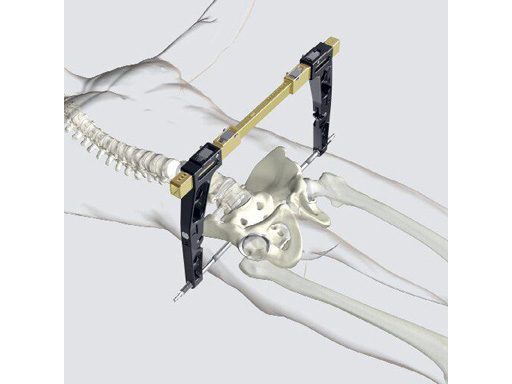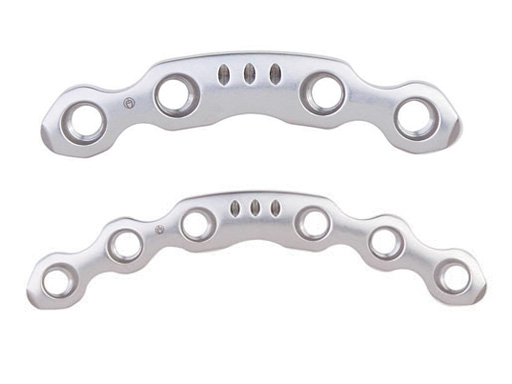
Low Profile Pelvic Set
A new Modular Pelvic System, covering nearly every aspect of pelvic and acetabular surgery, has been developed by the Pelvic Expert Group. It is composed of four different sets, which can be adjusted to personal or institutional preferences:
- Emergency stabilization with a ready to use pelvic C-clamp;
- Pelvic and acetabular instrument set with a wide range of standard instruments useful for solving nearly all problems in reduction and preliminary and definitive stabilization;
- Pelvic and acetabular implant set with improved, anatomically oriented plate designs and a new set of locking compression acetabular and pubic symphysis plates;
- An additional set according to the surgeons personal preferences such as percutaneous screw insertion, collinear reduction forceps, special retractors, and other instruments useful for specific techniques.
With this modular pelvic system a perfect combination between the demands for standardization of instruments and implants and the individual needs of the surgeons preferences could be realized. Grounded in the classical AO tradition, the modular pelvic system is supported by new concepts of teaching introduced in the AO pelvic courses, based on the differentiation of emergency and basic techniques and advanced and specialist techniques. The effective use of instruments and implants, clear and reliable concepts for emergency situations, elective pelvic and acetabular reconstructions and even more important concepts of analyses, decision making, nand surgical planning are all introduced.
Components of the Modular Pelvic System
1. Emergency treatment of unstable pelvic ring injuries with unstable circulation
The first module is assigned to the emergency stabilization of unstable pelvic ring injuries in combination with haemodynamic instability. The C-clamp, according to the proposals of R Ganz, has been redesigned and is now a ready to use device with a modified application modus, which allows a more controlled application even in emergency situations. A special training mannequin has been developed, which is useful for individual and group drill training within hospitals.
2. Pelvic and acetabular surgery instruments
The second module carries the standard instruments for pelvic and acetabular surgery. Both retractors and reduction instruments have been redesigned or complemented when necessary. They allow for all standard procedures for pelvic and acetabular surgery.
3. Pelvic and acetabular surgery implants
The third module holds all necessary implants for pelvic and acetabular surgery. The use of 3.5 mm pelvic screws with modified hex depth allows secure tightening and removal in long lengths. New pelvic plates have been introduced with an optimized design and screw hole geometry. Keeping the stability of the pelvic reconstruction plates, their smoothened outline allows safer and easier introduction underneath soft tissues. The screw hole geometry allows a wider range of screw angulations and the whole plate is easier to contour for speeding up the application process. The shape of the plates has been adapted to more closely fit the pelvic anatomy (J-plate), and as such, only minimal adjustments have to be made to fit to the individual anatomy.
For the first time a locking compression stabilization system is introduced in pelvic stabilization, taking into account the rapidly rising number of geriatric patients with the need for acetabular reconstruction. These plates will also provide increased safety in difficult situations with significant decrease of bone quality. The pubic symphysis plates allow for dynamic compression as well as for the use of locking head screws, and are precontoured to fit the public symphysis. They are available with 4 and 6 coaxial Combi holes. The plate has a 60 mm radius of curvature and featues 3 suture holes. It is cold-worked manufactured to improve strength. To facilitate the reattachment of the frequently disrupted rectus muscle additional holes for holding sutures have been added.
4. Pelvic and acetabular surgery optional instruments
A fourth module is available for the selection of specific and specialized instruments according to the individual surgeons preferences and demands. This could be the collinear reduction system, the 7.3 mm cannulated screws with the oscillation 2.8 mm drill guide for percutaneous transiliosacral screw fixations, or further instruments.
Summary
The new Modular Pelvic Set will provide a wide range of specialized instruments and implants suitable for nearly all presently available modern techniques in pelvic and acetabular surgery. Standard, reliable stabilizations as well as sophisticated reduced invasive procedures can be covered according to the surgeons and institutions knowledge and infrastructure. The modular set-up provides an easy adaptation to further techniques like image guided and navigated surgery. In conjunction with the well known AO teaching concept, a choice of instruments and implants are now available, which are specially adapted to pelvic and acetabular surgery.
The pelvic emergency training device
Unstable pelvic fractures with shock-induced hemorrhaging only account for a small percentage of pelvic injuries, but represent a life-threatening emergency for the patient. It is crucial for the patient that the treating physician recognizes the mechanically and, in some cases, hemodynamically unstable situation and has a good command of the emergency treatment techniques [13]. Adequate theoretical and practical training of doctors performing emergency treatment is essential [4].
The ADI has developed a pelvic emergency trainer device with which an unstable injury to the posterior pelvic ring with severe venous hemorrhage into the lesser pelvis can be realistically simulated. The emergency training device is closely associated with the development and application of the pelvic C-clamp.
The emergency training device (pelvic emergency trainer) is intended for courses, emergency training sessions, and assessment of learning achievements. Life-saving procedures, compression with the pelvic clamp, and tamponade of the lesser pelvis can be performed under the realistically stressful conditions of the emergency room. In addition, an unstable fracture adjacent to the knee joint has to be stabilized with an external fixator. If the clamp is incorrectly positioned or the tamponade ineffective, bleeding persists and is immediately visible to the surgeon in the form of a blood-red liquid which continues to flow. This exercise, performed under very realistic conditions, provides even experienced surgeons with valuable feedback. The exercise with the pelvic emergency trainer has already been integrated on several occasions into the pelvic management courses in Homburg/ Saar, Germany as a central element of the final assessment. The amount of positive feedback received is an indication that the pelvic dummy designed by the ADI in collaboration with AOI will also be a valued contribution to the curriculum at AO pelvic courses in the future.
The ADI has modified the pelvic emergency trainer and created a smaller version for the purpose of Synthes product training sessions. The small pelvic dummy has been transferred to Synbone and is being manufactured as a standard product. Synthes uses the small version for additional product training in the handling of the new emergency pelvic C-clamp in order to improve user confidence with this instrument. Compression of the anterior and posterior pelvic ring is evaluated by circulation of air after reduction and application of the pelvic clamp.
1 Bosch U, Pohlemann T, Tscherne H (1992) [Primary management of pelvic injuries]. Orthopde; 21(6):385392.
2 Pohlemann T, Culemann U, Tosounidis G, et al (2004) [Application of the pelvic C-clamp.]. Unfallchirurg; 107(12):11851191.
3 Seekamp A, Burkhardt M, Pohlemann T (2004) [Shock trauma room management of pelvic injuries. A systematic review of the literature]. Unfallchirurg; 107(10):903910.
4 Culemann U (2003) Lebensbedrohliche Verletzungen des Beckens - Ist die Technik erlernbar? Erfahrungen mit der Simulation. Vortrag A25.6, 67. Jahrestagung Deutsche Gesellschaft fr Unfallchirurgie, Berlin.
Aluminum Radiolucent Retractors
The Aluminum Radiolucent Retractors are intended for soft-tissue retraction during osteosyntheses. They allow fluorocscopic imaging without the need to remove and reinsert critical retractors. These are identical in design to current stainless steel versions used for extremity or hip and pelvis surgery.
Case new pelvic set
32-year-old man (165 kg), fell 7 meter into stairwell; bilateral open tibial fractures and both column fractures variant.
Hazards and labeling
Due to varying countries’ legal and regulatory approval requirements, consult the appropriate local product labeling for approved intended use of the products described on this website. All devices on this website are approved by the AO Technical Commission. For logistical reasons, these devices may not be available in all countries worldwide at the date of publication.
Legal restrictions
This work was produced by AO Foundation, Switzerland. All rights reserved by AO Foundation. This publication, including all parts thereof, is legally protected by copyright.
Any use, exploitation or commercialization outside the narrow limits set forth by copyright legislation and the restrictions on use laid out below, without the publisher‘s consent, is illegal and liable to prosecution. This applies in particular to photostat reproduction, copying, scanning or duplication of any kind, translation, preparation of microfilms, electronic data processing, and storage such as making this publication available on Intranet or Internet.
Some of the products, names, instruments, treatments, logos, designs, etc referred to in this publication are also protected by patents, trademarks or by other intellectual property protection laws (eg, “AO” and the AO logo are subject to trademark applications/registrations) even though specific reference to this fact is not always made in the text. Therefore, the appearance of a name, instrument, etc without designation as proprietary is not to be construed as a representation by the publisher that it is in the public domain.
Restrictions on use: The rightful owner of an authorized copy of this work may use it for educational and research purposes only. Single images or illustrations may be copied for research or educational purposes only. The images or illustrations may not be altered in any way and need to carry the following statement of origin “Copyright by AO Foundation, Switzerland”.
Check www.aofoundation.org/disclaimer for more information.
If you have any comments or questions on the articles or the new devices, please do not hesitate to contact us.
“approved by AO Technical Commission” and “approved by AO”
The brands and labels “approved by AO Technical Commission” and “approved by AO”, particularly "AO" and the AO logo, are AO Foundation's intellectual property and subject to trademark applications and registrations, respectively. The use of these brands and labels is regulated by licensing agreements between AO Foundation and the producers of innovation products obliged to use such labels to declare the products as AO Technical Commission or AO Foundation approved solutions. Any unauthorized or inadequate use of these trademarks may be subject to legal action.
AO ITC Innovations Magazine
Find all issues of the AO ITC Innovations Magazine for download here.
Innovation Awards
Recognizing outstanding achievements in development and fostering excellence in surgical innovation.


















